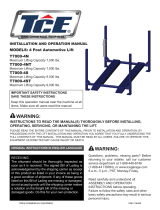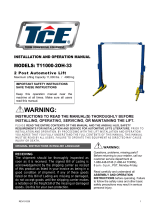
3
1. SAFETY
1.1. INTRODUCTION
Your Reimann & Georger Corporation Marine Products Railway Lift has been engineered to provide reliable performance, long term
economics, and safety advantages that no other type can match. However, even a well-designed and well-built railway lift can
malfunction or become hazardous in the hands of an inexperienced and/or untrained user. Therefore, read this manual and related
equipment manuals thoroughly before operating your railway lift to provide maximum safety for all operating personnel, and to get
the maximum benefit from your equipment.
WARNING:
DO NOT OPERATE THIS LIFT WITHOUT STUDYING THIS ENTIRE MANUAL. FAILURE TO
DO THIS CAN LEAD TO EQUIPMENT MISUSE WITH RESULTING SERIOUS PERSONAL
INJURY AND/OR DAMAGE. CONTACT YOUR RGC MARINE DEALER IF YOU HAVE ANY
QUESTIONS.
1.2. SAFETY DEFINITIONS
A safety message alerts you to potential hazards that could hurt you or others or cause property damage. The safety messages or
signal words for product safety signs are DANGER, WARNING, and CAUTION. Each safety message is preceded by a safety alert
symbol and is defined as follows:
DANGER: Indicates an imminently hazardous situation that, if not avoided, will cause death or serious injury. This safety message is
limited to the most extreme situations.
WARNING: Indicates a potentially hazardous situation which, if not avoided, could result in death or serious injury.
CAUTION: Indicates a potentially hazardous situation which, if not avoided, may result in minor or moderate injury. It may also be
used to alert against unsafe practices and property-damage-only accidents.
1.3. EQUIPMENT SAFETY LABELS
These labels warn you of potential hazards that could cause injury. Read them carefully. If a label comes off or becomes illegible,
contact a Reimann & Georger Corporation dealer for a free replacement.
1.4. EQUIPMENT AND PERSONNEL SAFETY
1. Do not use the lift if it shows any signs of damage.
2. Do not exceed the rated maximum lifting capacity of this equipment.
3. When using a motorized drive, understand the use of all controls and connections provided with it.
WARNING:
ALL ELECTRIC DRIVES MUST BE INSTALLED AND INSPECTED BY A CERTIFIED
ELECTRICIAN IN ACCORDANCE WITH LOCAL ELECTRICAL CODES. THIS
INSTALLATION MUST INCLUDE A PROPERLY WORKING GROUND FAULT CIRCUIT
INTERRUPTER. (G.F.C.I.)
4. Never try lifting anything other than a boat with this equipment.
5. Never allow people in the boat any time it is above the water on the carriage.
WARNING:
DO NOT STAND OR WALK ON THE CARRIAGE WHILE IT IS IN ANY POSITION. THIS
CAN CAUSE SERIOUS PERSONAL INJURY.
6. Do not allow anyone to swim or play under, near or on the lift at any time..


























